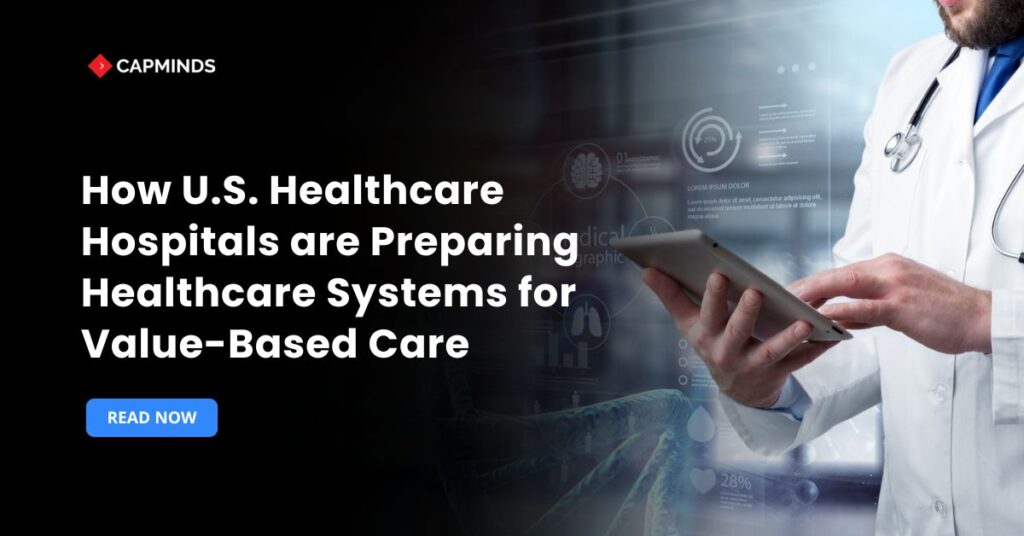How U.S. Healthcare Hospitals are Preparing Healthcare Systems for Value-Based Care
As the U.S. health system shifts from fee-for-service to value-based care models, hospitals must transform their IT systems and operations to focus on quality, outcomes, and efficiency. Value-based care means providers are paid based on patient health results and cost containment, rather than volume of services. This transition is urgent: U.S. healthcare spending reached an estimated $4.9 trillion in 2023. Hospitals and health systems need robust data and processes to reduce costs and improve outcomes.
To succeed, leaders are expanding IT budgets and prioritizing new technologies. For example, surveys report that three in four providers raised their digital and IT spending from 2019 to 2023, focusing on cybersecurity, electronic record modernization, analytics, and digital care solutions.
Value-based reimbursement requires a strategic IT foundation. Systems must collect, connect, and analyze patient data across the continuum of care. Key focus areas include interoperability, population health analytics, care coordination, patient engagement tools, and readiness for payment models. Below, we examine each area and why hospitals are investing in it.
Related: The Future of Healthcare: Key Value-Based Care Trends to Know in 2025
5 Ways U.S. Hospitals are Preparing for Value-Based Care
1. Building an Interoperable Foundation
Interoperable health IT is the backbone of value-based care. Hospitals have widely adopted electronic health records; federal data show that 96% of hospitals had EHRs by 2021, but connecting systems remains a challenge.
Certified EHRs must meet federal standards to exchange data, yet actual data sharing lags. Only about 70% of hospitals report they “sometimes” or “often” send, receive, find, and integrate electronic information across care settings, and only 43% do so routinely.
- Likewise, just 42% of clinicians say they regularly use information from other providers when treating patients.
- Hospitals have improved since 2018 (then only 46% exchanged information routinely), but routine data exchange is still too low.
- Closing this gap, for example, by connecting hospitals, clinics, long-term care, and home health, is critical.
- When data flows seamlessly, care teams can see a patient’s full history and avoid duplicate tests or medical errors.
- In VBC settings, routine data exchange helps control costs and improve outcomes by preventing events like avoidable readmissions.
Improving interoperability means upgrading IT infrastructure and data standards. Hospitals are investing in interfaces, Health Information Exchanges, and data warehouses to unify patient records. They are also beefing up cybersecurity and privacy controls to protect shared data.
These steps ensure that clinical information flows where needed. As one industry expert notes, compliant data exchange underpins high-quality, cost-effective care.
In practice, a hospital in an accountable care network might use shared data to run risk scores or to ensure that when a patient returns from a nursing facility, the ED sees their full care plan. Such interoperability efforts lay the foundation for all other VBC innovations.
Related: Healthcare EHR Interoperability in 2025: How to Choose the Right Solution
2. Leveraging Data Analytics and Population Health Management
Data analytics and population health tools turn raw data into actionable insight. In value-based models, providers must track quality and costs continuously.
This requires new infrastructure:
- Data warehouses
- Business intelligence dashboards
- Risk stratification engines, and
- Predictive models.
Hospitals are building “analytics hubs” that pull together claims, EHR, and even socioeconomic data. For example, enterprise data management platforms and integrated EHR systems can generate comprehensive utilization trends and financial analytics to inform care delivery.
With these tools, a health system can identify high-risk patients (for example, those likely to be hospitalized or readmitted) and intervene early.
- One powerful approach is applying artificial intelligence and machine learning to patient data.
- Surveys suggest 86% of hospitals already use some form of AI, mainly for automating notes or communications, and interest is growing.
- Predictive algorithms might flag a patient who is overdue for care, help match patients to programs, or forecast how patients will respond to treatments.
- For instance, AI can predict medication non-adherence or the need for immunizations, letting care teams intervene before problems arise.
However, advanced analytics depend on reliable data inputs. Payers and providers must share and unify data, including clinical records and even social needs information, to generate performance reports. Alternative payment models require frequent measurement, data analysis, and reporting to manage patient populations and track performance.
Hospitals are responding by building analytics teams and hiring new roles. Industry surveys find that many health systems have added population-health managers, data analysts, nurses, pharmacists, and care coordinators to meet VBC demands. Investment in analytics software is also rising: one report notes growth in tools for risk stratification, outcomes measurement, and quality dashboards.
Related: Supporting Population Health, CCM, and Behavioral Care with a Customizable OpenEMR Framework
3. Enhancing Care Coordination and Care Management
Value-based care incentivizes keeping patients healthy and out of the hospital. This means hospitals must coordinate with clinics, specialists, post-acute providers, and social services.
Care coordination platforms and workflows are essential tools. These can include shared care plans, transition-of-care management systems, and case management software that alert teams when patients move across settings.
- For example, few hospitals today consistently send care summaries to nursing homes or rehabilitation facilities.
- One national study found that only 16% of hospitals routinely sent discharge summaries to most or all skilled nursing facilities, and only 8% routinely received information back.
- This “disconnect” can contribute to high readmission rates.
- To address this, some systems have implemented automated referral-tracking and real-time notification tools so that primary care doctors, hospitalists, and specialists all see updates on a patient’s recent encounters.
- Care management teams – often made up of nurses, social workers, pharmacists, and other professionals – use these platforms to follow up with patients on chronic care plans, medication adherence, and post-discharge instructions.
- These interdisciplinary teams align around shared care pathways and use software to track protocols and referrals.
Hospitals are formalizing these processes as part of their VBC strategies. For instance, an accountable care organization may assign care managers to patients with diabetes who connect with them through secure messaging, home monitoring devices, and periodic in-person check-ins.
Technology like telemedicine and remote monitoring tools can extend the hospital’s reach into patients’ homes, enabling early intervention. Yet, legal and privacy considerations must be addressed when deploying such tools.
In practice, health systems often re-engineer workflows for better coordination: using a unified EHR, standard care protocols, and regular performance reviews.
They may also invest in population health management platforms that integrate claims and clinical data to give care teams a “single pane of glass” view of their patients. The goal is to reduce fragmentation: by connecting all stakeholders, hospitals can meet the quality metrics required by value-based contracts.
4. Empowering Patients with Engagement Technologies
Patient engagement is a core element of value-based care. Engaged patients tend to follow treatment plans and achieve better outcomes, which in turn drives value metrics. Hospitals are expanding tools that let patients be active partners in their care.
- According to industry data, about 76% of U.S. hospitals use telehealth to connect with patients remotely, up from only 35% a decade ago.
- Similarly, a recent survey found 93% of hospitals offer telehealth services, 97% support virtual visits, and 87% incorporate remote patient monitoring into treatment plans.
Beyond telehealth, providers offer patient portals, mobile apps, and automated messaging to engage patients. These digital channels allow patients to view their records, schedule appointments, refill medications, and communicate securely with care teams.
- For example, secure text reminders and app alerts can prompt patients to check blood pressure or attend follow-up visits.
- Hospitals report that making it easier for patients to access care and manage their health is are high priority.
- In value-based models, such tools help meet goals like keeping blood sugar or blood pressure controlled, since hospitals typically incur penalties for poor chronic disease management.
Importantly, engagement must address patients’ needs and preferences.
- Surveys show that patients are eager to use virtual care: during the COVID-19 pandemic, nearly 3 out of 4 Americans said they became more willing to try telehealth, and many older adults who had never used it did so in 2020.
- In this environment, U.S. hospitals are investing in user-friendly digital experiences.
- Some are integrating wearable monitors, smartphone health apps, and online communities into care programs.
- Others deploy automated “virtual assistants” and chatbots for triage and chronic care support.
- The underlying idea is clear: health systems are leveraging digital engagement to drive adherence, self-management, and preventive care, which all contribute to better value outcomes.
To ensure success, hospitals design these technologies with patient consent and clear communication in mind. For example, enrolment in a remote monitoring program typically includes informed consent and education about data privacy.
When done right, patient engagement platforms strengthen trust and encourage patients to stay healthy, exactly what value-based contracts reward.
5. Transforming Payment Models and Operations
The ultimate goal of IT and care redesign is to support new payment models. Across the industry, providers are moving away from traditional fee-for-service. They are negotiating risk-based contracts and alternative payment arrangements that reward quality and efficiency.
- Analysts project that value-based payment models could grow from about $500 billion today to $1 trillion shortly.
- One report notes that nearly 70% of Medicare Advantage enrollees in 2022 chose providers participating in value-based arrangements, reflecting patient preference for outcomes-driven care.
Preparing for these models means hospitals must change their operations and metrics. Financial and clinical data must be linked: IT systems need to track the cost of care alongside quality measures.
This often requires building or enhancing analytics platforms that can produce reports on care episodes, patient cohorts, and provider performance. Hospitals are also developing dashboards for real-time monitoring of key metrics tied to their contracts.
Operational Side
On the operational side, care teams are getting new tools to meet contractual requirements. For example, bundled payment programs may prompt hospitals to adopt expedited surgical pathways or deploy case managers to reduce post-surgical complications.
Population health software can automate tracking of preventive screenings or medication adherence for an assigned panel of patients. Every process change – from how referrals are handled to how follow-up visits are scheduled – is aligned with the contract’s success measures.
Leadership Level
At the leadership level, hospitals are often restructuring to be “payer-ready.” Many are expanding finance and contracting groups, forming ACO-like joint ventures, or affiliating with larger networks to share risk.
Industry data show that a substantial number of hospitals have entered affiliations or expect to do so under VBC pressures. IT supports these changes by enabling the consolidation of records and workflows across merged or partnered organizations.
Meanwhile, executives pay attention to regulatory compliance in these new models, ensuring, for example, that patient reward programs or care management initiatives meet federal guidelines.
Key IT and Organizational Priorities for VBC Readiness
Given the complexity of this transformation, U.S. hospitals are pursuing several strategic priorities in parallel:
1. Budgeting for digital transformation
A clear majority of health systems have increased IT budgets in recent years to support VBC initiatives. CIOs are targeting funds for analytics teams, cloud infrastructure, and modernization of legacy systems.
2. Strengthening data governance
As data flows across the continuum, robust governance is needed. Hospitals establish policies and committees to ensure data quality, patient consent, and compliance with privacy laws across all new programs.
3. Hiring and training talent
Many organizations have hired population health managers, data scientists, care coordinators, and other specialists. In one industry survey, nearly half of hospitals said they added population health staff and analytics roles in recent years. Workforce development programs and training on new tools (EHR modules, reporting platforms) are key.
4. Modernizing infrastructure
Systems upgrades – such as moving to cloud-based platforms, improving security, and implementing APIs – are ongoing. Up-to-date IT infrastructure ensures scalability and performance for data-intensive tasks like AI analysis or handling large patient registries.
5. Aligning culture and incentives
Beyond tech, hospitals are creating cross-department teams and incentives to meet VBC goals. For example, quality and IT staff may jointly oversee projects that tie into financial outcomes. Leadership communicates clearly how each team’s work feeds into the value proposition.
Together, these priorities form a comprehensive roadmap. By investing in IT and operations now, hospitals position themselves to thrive under value-based payment.
As one expert put it, emerging VBC arrangements emphasize quality, efficiency, and outcomes, so hospitals that build data-driven, patient-centered systems will have a competitive advantage.
CapMinds Strategic IT Consulting for Value-Based Care
As U.S. hospitals prepare for value-based care, aligning IT infrastructure with strategic goals is essential.
CapMinds Healthcare IT Consulting provides a structured roadmap to help you modernize core systems and operations for superior patient outcomes and financial performance.
Our value-based care consulting services include:
- Interoperability & Integration – Seamless data exchange across EHRs, post-acute partners, and community services. API and FHIR-based interfaces to break down information gaps
- Data Analytics & Population Health – Population health management platforms that aggregate clinical and claims data. Risk stratification, utilization trend analysis, and outcome monitoring.
- Care Coordination Solutions – Workflow integration and real-time notifications to reduce readmissions. Referral management and cross-disciplinary team enablement.
- Patient Engagement Technologies – Telehealth implementation, remote monitoring, and mobile portals. Automated messaging and digital tools to boost adherence and satisfaction.
- Alternative Payment Model Readiness – Operational alignment for bundled payments, shared savings, and capitation. Financial modeling support and performance metric dashboards.
Through comprehensive needs assessments, strategic planning, and technology alignment, CapMinds ensures scalable architecture, regulatory compliance, and cost-efficient implementation.
By partnering with us, your organization can optimize each value-based care component, interoperability, analytics, care coordination, patient engagement, and payment model transformation, while avoiding overspending on unnecessary tools.
Let CapMinds be your guide to value-based success: contact us today to begin your 2025 IT planning and transform care delivery for a healthier, more sustainable future.




